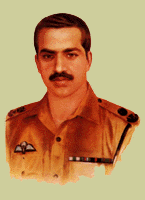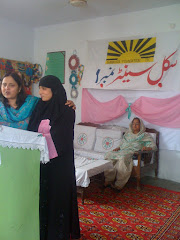


Nishan-e-Haider :- The Highest Military Award of Pakistan, made of gun metal, captured from the enemy in the previous wars, with a green ribbon and a star with five points is awarded to soldiers who Show great feats of bravery and courage in war or on active duty. It is a coincidence that all recipients of "Nishan-e-Haider' gave away the most valuable thing they had - their lives - in the service of the nation and in defending the frontiers of the motherland. So far 7 officers (including one from the Pakistan Air force) and three men have been awarded with this gallantry award. Here is a brief account of these men, who would be remembered for their feats of courage, bravery and selflessness.
|
|
| Captain Muhammad Sarwar |
Captain Muhammad Sarwar was born in village Singhori (Rawalpindi) in 1910, and joined the British Army (infantry -Punjab Regiment) in 1944. Upon creation of Pakistan he joined Pakistan Army. In July 1948 with war in Kashmir with India, Captain Sarwar launched an attack causing heavy casualties against a strongly fortified enemy position in the Uri Sector under heavy machine gun, grenade and mortar fire. On 27th July 1948, he volunteered to cut the enemy's barbed wire barrier to pave way for the move forward of his follow up comrades. However, while doing so he received a direct burst of enemy's heavy machine gun fire, and embraced shahadat at the spot. For his courage, selflessness and bravery, he was awarded with the first Nishan-e-Haider. Call it a coincidence, that the recipients of next two Nishan-e-Haiders were also from the Punjab Regiment.
| Major Tufail Muhammad |
Major Tufail Muhammad was born in 1914 and was commissioned in the 16th Punjab Regiment in 1943. Upon creation of Pakistan, he joined Pakistan Army. During 1958, with border skirmishes with India in the erstwhile East Pakistan, Major Tufail Muhammad was commanding a company of the East Pakistan Rifles near the town of Lakshmipur. The company encircled an illegal Indian post, which was erected by the Indians in violation of the internationally recognized boundary between the two countries. During the enemy action, Major Tufail was mortally wounded, but did not stop fighting even at close quarters. In the hand-to-hand encounter that followed, Major Tufail continued to lead his troops till the Indians were driven out, leaving four dead and three prisoners. However, Major Tufail himself succumbed to his wounds and embraced shahadat on the 7th August 1958. He was awarded with the second Nishan-e-Haider for his gallantry.
|
|
| Major Raja Aziz Bhatti |
Major Raja Aziz Bhatti was born in 1928 in Hong Kong and joined the 1st PMA Long Course and was commissioned in 1950 in the Punjab Regiment. He was a very well read officer, having passed out with the coveted Sword of Honour and knew many foreign languages. During the 1965 Indo-Pak war, he was commanding a company in general area Burki of the Lahore Sector. Major Bhatti's defences on the famous BRB (Banmban Wali Ravian Bedian) Link Canal was subjected to heavy Indian repeated attacks coupled with incessant artillery and tank fire for five days and nights. But Major Bhatti and his men stood like a rock. In order to have a clear view of the assaulting enemy, Major Bhatti would often come out of his bunker and stand clear of the canal bank. On 10 September 1965, while he was directing the artillery fire, he was hit by an enemy tank shell. Major Bhatti embraced shahadat and was awarded with the third and the only Nishan-e-Hiader of 1965 war.
|
|
| Pilot Officer Rashid Minhas |
Pilot Officer Rashid Minhas was born on 17th February 1951 and during 1971, he was under training in the Pakistan Air Force. In August 1971, when the Indians had put lot of pressure in the eastern wing, Rashid Minhas was busy in his routine training at PAF Base Masroor. On that fateful day of 20 August 1971, while he was taxiing his aircraft towards to runway, a Bengali dissident Instructor Pilot (IP) forced his way into the rear cockpit of the two-seat jet trainer and in the process hurt Rashid Minhas. The IP seized control of the aircraft and headed toward India. When Minhas regained consciousness, he realized that the absconding pilot was heading towards India, so he tried to regain control of the plane. But being injured, he was not able to take power on the controls, so he forced the aircraft to crash some thirty two miles short of the border. By losaing his own life, he not only saved the aircraft from getting in to the hands of the Indians, but also jeopardized the malafide intentions of his IP. He became the first PAF officer to receive Nishan-e-Haider.
|
|
| Major Muhammad Akram |
Major Akram was born in 1938 in village Dingha (Gujrat) and was commissioned in the Frontier Force Regiment in 1963. During 1971 Indo - Pak war, Major Akram was commanding a rifle company of the 4th FF Regiment in the forward localities of the Hilli district. The position held by Major Akram and his company was very vital and had blocked enemy's route of advance. Therefore it came under continuous and heavy air, artillery and tank attacks. But for almost two weeks, despite enemy superiority in both numbers and fire power, Major Akram and his men remained entrenched and repulsed every attack, inflicting heavy casualties on the enemy. The Indians many a time asked him to surrender but Major Akram refused. Finally, overpowered and fatigued, Major Akram embraced shahadat fighting at close quarter battle in the famous "Battle of Hilli" and was awarded with the fifth Nishan-e-Hiader.
|
|
| Major Shabir Sharif |
Major Shabir Sharif was born in 1943 in village Kunjah (Gujrat) and was commissioned in 1964 in the Frontier Force Regiment. During the 1965 Indo-Pak war, Major Shabir Sharif was awarded with Sitara-e-Jurrat (the third highest gallantry military award) for his courage and bravery. In 971, Major Shabir's 6 FF Regiment, was ordered in December 1971 to capture high ground near Sulemanki Headwork defended by more than a company of the Indian Assam Regiment supported by a squadron of tanks. Major Shabir and his men after crossing a minefield and massive obstacles and killing forty three soldiers and destroying four tanks, Major Sharif and his men held two enemy battalions at bay for days. However, on 6 december, the Indians mounted a fierce attack supported by tanks. Assessing the situation to be critical and not taking any chances with the enemy, Major Shabir himself took over an anti-tank gun from his gunner and fired on the enemy tanks. While doing so, the enemy tank fired its main gun on Major Shabir's location, killing him in the afternoon of 6th December. Brave as he always was, he proved his mettle once again and was awarded with the coveted Nishan-e-Haider.
|
|
| Sowar Muhammad Hussain |
Sowar (the basic rank in the Armoured Corps equivalent to a sepoy) Muhammad Hussain was born in 1949 in Dhok Pir Bakhsh and joined the 20 th Lancers (Armoured Corps) as a driver in 1966. Sowar Hussain was always eager to perform jobs that were not normally meant for drivers and was always in fore fronts to help the others. During the 1971 war, he spotted the enemy digging along a minefield near the village of Harar Khurd. Daring as he was, he on his own initiative called and directed accurate fire at the enemy resulting in the destruction of sixteen of their tanks. However, strange are the ways for the gallant and brave men chosen for them by the Almighty. While he was still directing fire from a recoilless rifles, he was hit in the chest by a burst of machine gun fire and embraced shahadat on 10th December 1971. While he was awarded with the Nishan-e-Haider for his courage and bravery, his village elders as a tribute to his bravery renamed their village as Dhok Muhammad Hussain Janjua.
|
|
| Lance Naik Muhammad Mahfooz |
Lance Naik Muhammad Mahfooz was born in 1944 at Pind Malikan (District of Rawalpindi) and was enlisted in the 15th Punjab Regiment as a sepoy in 1962. In 971 Indo Pak war, he was serving in the 'A' Company and his unit was deployed on the Wagah-Attari Sector near Lahore. The enemy advancing elements pinned down his company positions by unceasing frontal and cross fire from automatic weapons. In the process, his machine gun was destroyed by an enemy shell, but it did not dishearten the spirited Lance Naik, who advanced bare handed towards an enemy bunker whose automatic fire had inflicted heavy casualties. Even though wounded in both legs by shell splinters, when he reached the bunker he stood up and pounced on the enemy, but was hit. Although unarmed and amidst the enemy, he got hold of one of the enemy and was strangling him when another bayoneted him to death during the night of 17th December 1971. Living true to the traditions of the Punjab Regiment, whose three officers had already won Nishan-e-Haider, Lance Naik Muhammad Mahfooz also showed no less courage and gallantry in winning the fourth medal for the Punjab Regiment. Pin Malikan has now been renamed as Mahfoozabad.
|
|
| Captain "Karnal" Sher Khan |
Captain "Karnal (meaning a Colonel)" Sher Khan was commissioned in Pakistan Army in 1990 and later joined the Northern Light Infantry somewhere in 1998. Right from his childhood, he displayed feats of courage and was nicknamed "Kernal" by hisa fellows, which ultimately became a part of his name. Captain Karnal Sher Khan rose to the heights of glory when he emerged as the symbol of mettle and courage during the Kargil conflict on the Line of Control. He set personal examples of bravery and inflicted heavy losses on the enemy. He defended the five strategic posts, which he established with his jawans at the height of some 17,000 feet at Gultari, and repulsed many Indian attacks. After many abortive attempts, on July 5 1998, enemy's two battalion ringed the post of Kernal Sher Khan with the help and unleashed heavy mortar firing and managed to capture some part of the post. Despite facing all odds, he lead a counter-attack and re- captured the lost parts. But during the course he was hit by the machine-gun fire and embraced Shahadat at the same post. For his courage and bravery, he was awarded with Nishan-e-Haider.
|
|
| Havildar Lalak Jan |
Side by side the officers, the men of the Northern Light Infantry, like Havildar Lalak Jan, displayed similar feats of gallantry as were displayed by Captain Kernal Sher Khan and fought furiously to thwart heavy Indian attacks. Although an appointment holder, whose task is to look after his men and provide administrative support, Havildar Lalak Jan volunteered himself to be deployed on the front positions located at the jagged peak in May 1999. Havildar Lalak Jan repulsed many aggressive ventures by the enemy and imposed colossal losses on the enemy. On July7, Havildar Lalak Jan sustained serious injuries as enemy pounded the area with heavy mortar fire. But despite being injured, he retained his position and frustrated the Indian assault. He, however, succumbed to his injuries at the same post he was defending. Havildar Lalak Jan was awarded with the Nishan-e-Haider for his courage and fighting beyond the call of the duty as an appointment holder.





















































































No comments:
Post a Comment